Celebrity and fashion photographer David Jensen, best known for the images he created during the 1990s and early 2000s of everyone from Angelina Jolie to Phyllis Diller, lost his long battle with depression on November 9. He was 52.
Jensen, along with lensmen like David LaChapelle and Carter Smith, was part of a new wave of young, unapologetically gay American photographers who collided head on with the status quo of end-of-the-'80s stoic, materialism-driven photography. These era-defining upstarts approached their visuals with a punkish DIY manifesto while also infusing them with the kinetic energy of the newly evolved queer identity. The result was a rapid transformation of contemporary photography into something more accessible, playful, and brimming with possibility.
Not long after his 1989 graduation from the Art Center College of Design in Pasadena, Calif., Jensen's work was splashed lavishly throughout influential glossies such as Details and Sassy. He photographed A-list film actors for the cover of Entertainment Weekly and alternative rock stars for the pages of Spin. By his mid-20s, David was meeting with Vogue editrix Anna Wintour in her Manhattan office to formulate celebrity shoots for the fashion bible. This early success was not just due to his fresh vision and youthful enthusiasm. His affable disposition was key as well.
"David was unfazed by celebrity. He didn't put on airs, either," recalls Mark Harvey, an assistant professor at Art Center and former Advocate art director. "He photographed some of the most famous and iconic people, and yet, he would somehow act as if he had known them all along. It certainly made for candid and arrestingly authentic portraits."

I first met David in 1996 while employed as The Advocate's photo editor. His photography promo card appeared in my mailbox at the magazine's Hollywood Blvd offices and I was both stunned and thrilled! To have the magazine courted by a young photographer of Jensen's caliber back then felt, well ...epic!
At that point in history, Ellen DeGeneres, Rosie O'Donnell, and George Michael were all still in the closet. Will & Grace was two years away and the military's "don't ask, don't tell" policy was solidly in place. Working for an LGBTQ+ newsmagazine in the mid-'90s was not considered an ideal career move for someone his age. Long-established, out photographers like Herb Ritts and Greg Gorman could contribute to the publication with virtually no risk, but Jensen was putting his meal ticket on the line.
During our first meeting, David revealed that he'd long admired what the magazine had done and aspired to do. Like most LGBTQ+ people of his generation, David had suffered losses during the AIDS crisis and wanted to be a part of the magazine's battle against senseless death and the fight for equality. He graciously agreed to work with our lean budgets, which paled in comparison to those afforded to Conde Nast publications.
"The first time I worked with David was in 1998, just after I became the art director for The Advocate," Craig Edwards, creative director for Deadline Hollywood recollected. "It was a cover shoot with Chastity Bono, who was very nervous and camera shy, but David put Chastity at ease. I don't think he even pocketed any money from that session."
Jensen was tall and handsome with welcoming blue eyes and a big, beautiful smile that is unanimously described by friends as able to "light up a room." So it was unsurprising to most who encountered him that David worked in Japan as a fashion model prior to his career as a professional photographer. But his takeaway from his modeling gigs did not seem to be the currency made available by his visage. Rather, his comprehension of the level of vulnerability required for staring back at the camera's lens increased tenfold.
"What stands out the most in my memory is our shoot with Liza Minnelli in Las Vegas in [1996]," said Judy Wieder, The Advocate's first female editor-in-chief and author of the memoir Random Events Tend to Cluster. "This was a very vulnerable time in her life. David sensed this immediately and stepped in with such insight and tenderness, I could see Liza's skin literally relax. Yes, great talent. Yes, great technique. But most importantly, great heart!"
 Kevin Zegers for Out, 2006
Kevin Zegers for Out, 2006
In 2003, Jensen shifted his life and career priorities towards increased stability and accepted a day job as Out magazine's photo editor. By 2006, however, his depression had become unmanageable. David left the magazine and checked himself into a hospital. Around that same time, fellow '90s "it boy" photographer, David LaChapelle, was hospitalized and diagnosed with bipolar disorder. Both men left the industry that year. LaChapelle moved from Manhattan to Maui. Jensen relocated from Los Angeles to Sacramento, Calif.
Early in 2018, David and I began video chatting regularly. He had relocated again in 2016, this time to Portland, Ore., where he was being treated for chronic depression. Though he seemed more content in Portland than he'd been elsewhere in recent years, his medical team had yet to make significant inroads with his treatment plan. Having had my own battles with depression over the years, David and I were able to compare notes on symptoms, medication, and living life with challenged mental health. At times we even laughed together about our predicaments, thanks largely to David's still intact (though less frequently displayed) wicked sense of humor. During the summer, David confessed to me how he'd often found it easier to just smile and pretend "everything's ok" rather than summon the strength to educate the inexperienced about mental health. "Why not just think positive?" was a question we'd both come to loath.

L7 for Spin, 1993
David convincingly expressed to me his desire for gaining an upper hand against depression. However, as fall approached, he resorted more and more to brief communication via text message. These messages revealed an apparent flatlining of David's progress. I didn't know how to help other than to remind him that I'd had victories over depression and that he was loved.
On November 13, David's sister, Kathy, shared the devastating news of his passing with his Facebook family.
It's a common practice to search for the most succinct definition of an artist's impact after they have left us. David Jensen's legacy certainly includes his undeniable role in redefining photography during the 1990s, as well as, an unprecedented ability to put subjects at ease. Ultimately, it is just as likely that he will be remembered most fondly for his humanity:
"I know [David] struggled, but I will remember the moments of laughter and joy," said Chilly Nathan, a film and television production designer and former Out photo editor. "I am forever grateful he shared his pain with me; because it made me feel not alone in this thing we call depression. David taught me it doesn't define us, it just is. I'm sorry his journey has ended--but not sorry for David, sorry for the world, for his beautiful and talented soul will surely be missed. But my friend gets to rest now."



 Kevin Zegers for Out, 2006
Kevin Zegers for Out, 2006


































































Charlie Kirk DID say stoning gay people was the 'perfect law' — and these other heinous quotes